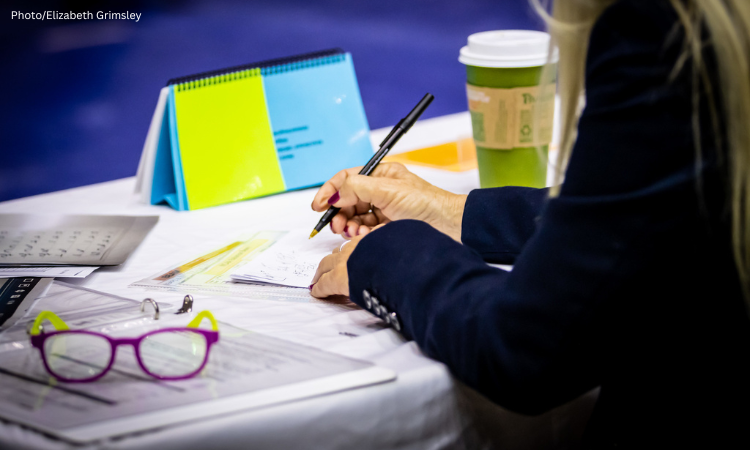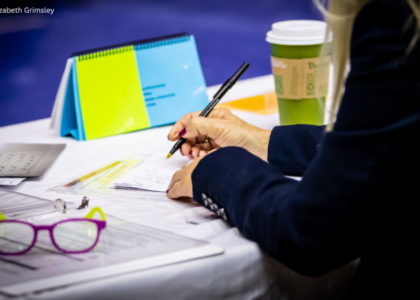One of the favorite pastimes of gymnastics fans is complaining about the scoring. Do you think you could do better? Become a judge!
There is a huge shortage of gymnastics judges nationally. As the sport continues to flourish at developmental levels, state judging directors struggle to find enough qualified judges to meet the demand, and it’s no different for college meets.
Some tri meets this year required teams to have a “bye” rotation because there weren’t enough available judges to cover every event. Developmental meets and NCAA meets compete for the same judges, making some weekends in January and February very difficult to meet the demand.
Anyone can become a judge, but it takes a high level of dedication, commitment, and studying to sit in the chair at the national championships. Here, I’ll outline the steps and some resources you can use to get started.
(If you’re already a judge, skip to step eight to see how to judge college gymnastics!)
Step 1: Contact your state judging director (SJD)
The National Association of Women’s Gymnastics Judges (NAWGJ) is a national organization but is largely administered on a state level. NAWGJ maintains a list of all SJDs, organized by region. Send an email to your SJD, introduce yourself and your background with gymnastics, and tell them that you are interested in becoming a judge. Ideally, they will respond and send you everything you need to get started, as well as mentor you or assign someone to mentor you through the process.
If that doesn’t happen, NAWGJ has additional resources as a starting point for new judges that explains a lot of what I’ll cover in this article.
Step 2: Learn the rules
Most gymnastics fans are likely familiar with NCAA rules, but as a new judge, you have to start with beginner athletes, who use different rules, before you can judge in college. Most judges start with the USA Gymnastics (USAG) program and learn the compulsory, optional, and Xcel rules. As a judge, you’ll eventually need to know all the neutral deductions, execution deductions, the value of every skill (A-E) in the developmental program, the compulsory routine composition and choreography, specific compulsory deductions, and the Xcel special requirements and rule modifications.
I’d recommend starting with the level 4 and level 5 compulsory rules and execution deductions. If you’re very ambitious, you can also take the level 8 exam, where you will need to know all of the A-C level skills and special requirements. For level 9 and 10, you will need to know the upper level D/E skills, as well as how to calculate bonus and start values in each level.
If you want to judge in AAU leagues, you can do so with an AAU membership and without an additional exam. AAU has almost identical rules to USAG, with some minor adaptations to make the code a little more forgiving for athletes that are competing or omitting skills they haven’t mastered. The National Gymnastics Association, a newer organization, has its own code of points and judging exam that does not require USAG membership or knowledge of the USAG code. It has one set of rules from beginner to advanced competitors, with no compulsory routines. However, if you want to eventually judge in college, you will have to make your way up through the ranks of the USAG Rating System. The popularity of AAU or NGA compositions varies by state, so if you are interested, ask your state judging director what the demand is like for judges before you spend the time and the money preparing.
Step 3: Practice and take the test
If you’re a former NCAA athlete or coach or a former Level 10 regional or national qualifier or coach, you can take your compulsory (level 4/5 test) and your level 9 test at the same time. If you’re a former elite gymnast or coach, you can take your level 10 test right away. In both cases, you have to apply and be approved by USA Gymnastics using this form. This option exists to fast-track potential judges that are already very familiar with the sport. However, judging is a completely different skill than performing or coaching gymnastics, so if you are able to take this shortcut, make sure you’ve practiced judging and are ready to go. You may find yourself as a head judge in your first season at age-group meets with athletes compulsory, Xcel, and optional. Although the test is only for level 9 and 10, you will still need to know the rules and evaluate the athletes at all the lower levels as well.
For everyone else, you can test both the compulsory levels (level 4/5) and beginner optional (level 8) in the same year. After one year at a level 8 rating, you can test level 9 and the following year level 10. The compulsory test is a one-hour, open-book exam with 50 questions. Usually there are 10 “general” judging questions and 10 event-specific questions per event. The other three optional exams have a similar 50-question, timed, online, written component but also include a practical exam. The practical exams are in-person and require you to judge six routines on each event (plus an example). The most inaccurate score will be dropped, and you will be evaluated on the five best judgments.
Both NAWGJ (at state and national levels) and USAG have a lot of resources to practice judging, both online, in the gym, or at a competition. YouTube also has a lot of parents that have posted routines of their gymnasts, which is a free and convenient way to practice, as they usually also post the scores.
Now is a great time to start the process of becoming a judge. Most tests are offered at the end of the summer, and there are plenty of clinics to attend to learn about judging. Plus, your rating is good until the rules change: every eight years for compulsory (2029) and every four years for optionals (2026).
Step 4: Pay your dues
Getting started as a new judge can be costly, so I’ve broken down the costs to get started and maintain your rating as a judge. The good news is that most state NAWGJ groups host a “judges cup” competition, which serves as a fundraiser to cover some of the costs related to continuing education, testing, or reference materials, but it varies from state to state.
Costs
| Judging Requirements | Costs | Frequency |
| USAG membership | $97 | Every year |
| NAWGJ membership | $60 | Every year |
| Background check | $30 | Every two years |
| SafeSport training | $0 | Every year |
| USAG Safety and Response Policy course | $0 | Every year |
| Safety and risk management training | $65 | Every four years |
| NAWGJ uniform | Men’s or Women’s Blazer and Pants: $210-$280 NAWGJ Dress: $89 | As needed |
| Reference materials | Compulsory code: $75 Optional Code: $75 Xcel code: $75 | Every new cycle (four years for optional, eight years for compulsory) |
| Testing | Compulsory: $25 Level 7/8: $50 Level 9: $50 Level 10: $50 | Every new cycle (four years for optional, eight years for compulsory) |
| Continuing education clinics | Regional Congress: $190 – $210 plus travel expenses National Congress: $260 plus travel expenses Online Courses: $15 each | Annually |
| Supplemental materials | Variable, many free options available | As needed, usually with rule changes |
| Additional memberships | AAU: $13 NGA: $35 |
Step 5: Look the part
Ever wondered why judges all look the same? There are very clear, strict uniform requirements for gymnastics officials at every level. The required uniform is a Lands’ End blue suit, with the NAWGJ patch, a white shirt, neutral shoes, and an optional coordinating scarf/tie. Most states allow new judges to wear a blue suit rather than the official uniform in their first year to make it less expensive for a new judge but check with your SJD to confirm. Some meet directors will host a “theme meet” where they will specify an alternative uniform for the judges. However, the default uniform is always the blue NAWGJ suit.
Step 6: Get paid
Obtaining and maintaining your judging certification is expensive, but it does pay pretty well, especially for college or graduate students. The other advantage is judges can set their own availability, so you can accommodate your primary schedule and only judge when you want or are available. Your pay varies based on your rating, with compulsory judges at the low end ($18/hr in 2023) to Brevet judges at the top ($36/hr in 2023). Judges also receive reimbursement for mileage and are provided meals or a meal stipend.
With the considerable cost to start judging, it can take a while to recover your costs. However, all costs are tax deductible against the revenue you generate from your hourly judging rate. Make sure you save all your pay stubs and expenses to properly file your taxes at the end of the year!
The specifics regarding judging compensation and regulations regarding judges are available in the USA Gymnastics Rules and Policies. NCAA compensation is variable and depends on the school. Most schools pay a flat rate ($150-$300 as a general estimate) and cover all travel-related expenses through reimbursement or by directly booking flights, hotels, etc.
Step 7: Maintain and upgrade your rating
Now that you’ve finished your first year as a judge, you have to complete a certain number of continuing professional education requirements to remain eligible to judge USA Gymnastics competitions. These requirements can be met by attending clinics, volunteering, or spending time in the gym with athletes. The number of required credits varies by the judges rating level and includes a minimum number of clinic hours that usually require a judge to register for an online course or attend a regional or national conference. State NAWGJ chapters will often have free (or reduced) local clinic offerings where you can receive your required clinic hours at a much lower expense than a regional or national clinic.
Step 8: Sign up to judge college gymnastics
Once you’ve worked your way through the system and passed your level 10 judging exam, you can be eligible to judge NCAA. Start by visiting the NAWGJ website and completing the “New to College Judging” form. Every fall, you will need to enter yourself in the national judges’ assigning system for college competitions and complete an open-book, untimed, 50-question test about the NCAA Rules and Modifications. You’ll also need to enter your basic contact information and availability and be careful to coordinate your availability between NCAA and USAG weekends. As a new NCAA judge, it’s recommended to practice judging a live NCAA session prior to being assigned. Reach out to your SJD to find out about NCAA practice judging opportunities.
As you can see, it’s a long, time-intensive, and expensive process to become a judge, especially if you want to judge at the collegiate level. But is it worth it? To quote Ghandi, “Be the change you want to see in the world.” If you really want to improve college gymnastics scoring, what better way to do so than to be the one sitting in the chair?
READ THIS NEXT: Judge’s Inquiry: Breaking Down Every Perfect 10 From Nationals
Article by Rhiannon Franck
Rhiannon Franck is a former national-rated NAWGJ women’s gymnastics judge with over 15 years of USAG judging experience and nine seasons judging NCAA gymnastics. Outside of gymnastics, Franck works at a university as a nursing professor and loves to travel.
Like what you see? Consider donating to support our efforts throughout the year! [wpedon id=”13158″]




Great job! As I read this I couldn’t help but think of how many times I’ve heard fans with little or no understanding of WAG say that they could do a better job than the professional judges, well here is their chance.